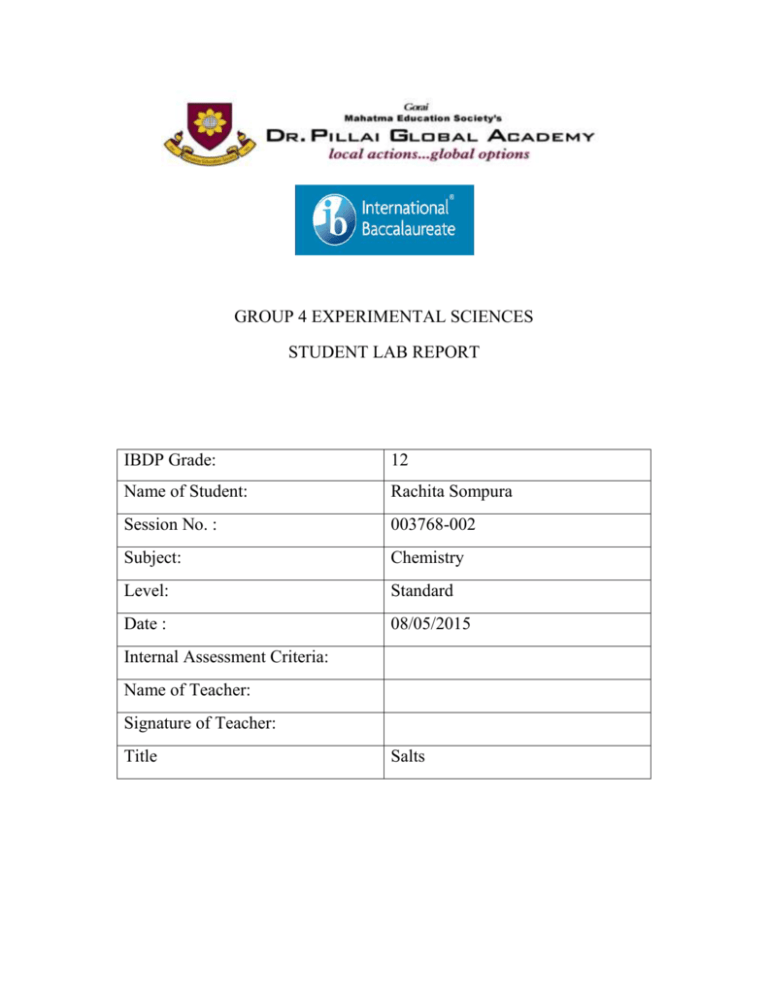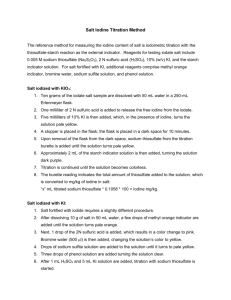chem IA
advertisement

GROUP 4 EXPERIMENTAL SCIENCES STUDENT LAB REPORT IBDP Grade: 12 Name of Student: Rachita Sompura Session No. : 003768-002 Subject: Chemistry Level: Standard Date : 08/05/2015 Internal Assessment Criteria: Name of Teacher: Signature of Teacher: Title Salts Title:Salts Investigation:calculating the amount of iodine present in 5 various salts Hypothesis:5 various salts are to be taken and the amount of iodine is to be calculated. This will be done by the method of titration taking sodium thiosulfate in the burette. Potassium iodide and dil. Sulfuric acid are to be mixed in the salt and water solution. Later, after adding starch, titrate the solution and perform the calculations by the help of the readings collected. Variables list: Independent variable: Types of salts (Five samples used in the expt ) Dependent variable: amount of iodine Controlled variables: Amount of starch , Material list: Beaker (250ml) Burettes ( ) Glass rods Graduate cylinder (50 mL) (250ml) Containers calibrated by volume to weigh salt Conical flask (250ml) Volumetric flasks 250 mL Funnel Weighing machine to weigh 50g of salt Diagram or photograph Reagents 0.005 N-Sodium Thiosulfate Solution5: Dissolve 1.24 g Na2S2O3.5H2O (FW= 248) in one liter of distilled water and store in a cool dry place. Solution is stable for 1 month. This amount is sufficient for about 200 samples. 2 N-Sulfuric Acid Solution: Using concentrated sulfuric acid, slowly add 60 mL to 900 mL of distilled water and mix. The solution is cooled down and made up to one liter. This amount is sufficient for about 1,000 samples. 10% Potassium Iodide Solution: Dissolve 100 g of potassium iodide in water and make up to one liter. Store in a cool dark place, this solution is stable for 6 months provided there is no color change. This amount is sufficient for about 200 samples. Starch Solution: Weigh 1 gram of soluble starch into a 100 mL beaker and add 10 mL of water, heat to dissolve. The thiosulfate solution can be standardized by titrating with a standard 0.005Npotassium iodate solution. This standard solution is prepared from a 0.5 N solutions made by dissolving 4.4585 g analytical grade KIO3 in water and making up to 250mL. The 0.5 N solution is diluted 100-fold by taking 2.5 mL and diluting to 250 mL with distilled water. Normality of the thiosulfate solution = [volume KIO3 (sol)/ volume thiosulfate (sol)]/ xm Normality of iodate solution (0.005 N)] Prepare a saturated solution of sodium chloride dissolving NaCl in 80 mL of distilled water, heat up the solution until no more NaCl dissolves. Cool the solution and add to the dissolved starch, and make up to 100 mL. Store in a cool dark place, this amount is sufficient for about 50 samples. Prepare the starch solution every day. The saturated NaCl solution is stable for 12 months. Procedure: Solubilisation of the salt sample 1. Weigh accurate 50g of salt and add the mixture of distilled water and salt into a 250ml volumetric flask. 2. Transfer 50 ml of the salt solution Transfer 50 mL of the salt solution using a 50 mL pipette to a 200 mL Erlenmeyer flask. 3. using a graduated pipette add 1 mL of the 2-N sulfuric acid to the salt solution and mix thoroughly. 4. Add 5 mL of the 10% potassium iodide solution using a measuring cylinder or a pipette. If iodine is present a yellowish solution is formed. 5. Cover the flask and put in the dark or in a cupboard for 10 minutes. Titrating iodine in the salt solution 6. Fill the 50 mL burette with the thiosulfate solution in readiness for titration. 7. Titrate the iodine solution in the flask with the thiosulfate and stop the titration when the dark color of the solution turns to pale yellow. Agitate the salt solution continuously. 8. Add 2 mL of the starch solution and the solution should turn blue. Mix thoroughly. 9. Resume titration with thiosulfate until the blue color disappears. Agitate the salt solution continuously and gently. 10. Record the volume from the burette or serologic pipette as accurately as possible to the nearest 0.1 mL. Calculations: The amount of potassium iodate in the salt is determined using the following equation. 1 (mg/kg) = N Na2S2O3 (eq/L) × vol Na2S2O3 (ml) × 21.222 (g/eq l) initial volume (ml) w (kg) × used volume (ml) If the procedure is strictly followed the prior formula could be simplified to: 1 (mg/kg) =0.005 Na2S2O3 (eq/L) × vol Na2S2O3 (ml) × 21.222 (g/eq l) 250 (ml) 0.05 kg × 50 (ml) The final equation is as follows: 1 (mg/kg) = 10.61 × vol Na2S2O3 (ml) Observations tables: Experiment no. 1. To calculate the iodine ppm, net reading was multiplied by 10.6 and the results were found. For an example, the first reading: 7.6(initial reading) – 5(final reading) = 2.6(net reading) Therefore, 2.6 × 10.61 = 27.56 The above 10.6 value is constant for all the readings taken throughout all the experiments. No. of readings 1 2 3 4 5 No. of readings 1 2 3 4 5 Salt Sample Sample A Salt Sample Sample A Initial reading/ml 5.0 7.6 10.9 13.4 15.9 Iodine ppm 27.6 24.4 26.5 26.5 27.6 Final Net reading reading/ml ml 7.6 2.6 10.9 2.3 13.4 2.5 15.9 2.5 18.5 2.6 Average Iodine ppm 26.52 Uncertainty in Iodine ppm 1.6 (Rounded to one decimal) 2.0 Iodine ppm 27.6 24.4 26.5 26.5 27.6 Sample Calculation shown for averaging iodine ppm : = = (27.6+24.4+26.5+26.5+27.6) (132.6) 5 5 = 26.52 Uncertainty in Sample A: = Maxima – Minima 2 = 27.6−24.4 2 = 1.6 Rounded to 1 dp = 2.0 Percentage Uncertainty : = 2.0 ∗ 100 26.52 = 7.54 % = 8.00 % Experiment no. 2 To calculate the iodine ppm, net reading was multiplied by 10.6 and the results below were found. For an example, the first reading: 11.1 (initial reading) – 7.8(final reading) = 3.3(net reading) Therefore, 3.3 × 10.6 = 35.0 The above 10.6 value is constant for all the readings taken throughout all the experiments. No. of Salt readings 1 Tata salt 2 3 4 5 Initial reading 7.8 11.1 16.2 20.0 23.9 Final reading 11.1 16.2 20.0 23.9 27.7 Net reading Iodine ppm Initial reading 26.7 29.1 31.7 34.4 37.1 Final reading 29.1 31.7 34.4 37.1 39.9 Net reading Iodine ppm Initial reading 29.1 30.7 32.2 33.8 35.3 Final reading 30.7 32.2 33.8 35.3 37.0 Net reading Iodine ppm Initial reading 00 Final reading 00 Net reading Iodine ppm 3.3 4.1 3.8 3.9 3.8 35.0 43.5 40.3 41.3 40.5 Experiment no. 3 No. of Salt readings 1 Saffola salt 2 3 4 5 2.4 2.6 2.7 2.7 2.8 25.4 27.6 28.6 28.6 29.7 Experiment no. 4 No. of Salt readings 1 Topline salt 2 3 4 5 1.6 1.5 1.6 1.5 1.7 17.0 15.9 17.0 15.9 18.0 Experiment no. 5 No. of Salt readings 1 Salt pan 00 00 2 3 4 5 00 00 00 00 00 00 00 00 00 00 00 00 00 00 00 00 There was no colour change observed after adding potassium iodide and dil. sulfuric acid or starch. Therefore, there were no readings taken and was hence proved that salt pan does not contain iodine. Graph : I o d i n e Iodine ppm Level for 5 sample of 50 g v/s various sample 50 45 40 35 30 25 p 20 p m 15 10 5 0 Salt A Salt B Salt C Salt sample Salt D Salt E Iodine ppm v/s various salts I o d i n e p p m 50 45 40 35 30 25 20 15 10 5 0 Series1 Salt A Salt B Salt C Salt D Salt E Various salts After performing the experiment we found the content of iodine is different in various sample used in the experiment. We also found that the last sample E was very different as compare to other salts as the content of iodine level was almost zero throughout for five different readings . We calculated the average of five sample per salt and the average uncertainty for those five different readings. From the samples we collected for our experiment the content of iodine mention on wrapper Sr No. 1 2 3 4 5 Salts Sample A B C C D Iodine Content/mg 30.00 15.00 30.00 15.00 0.64 The percentage error in sample A was 8 %, Sample B is 10 % , Sample C is 7 %, Sample D is 6 % and Sample E has zero iodine content which leads to NO percentage error in that calculation. Iodine ppm in sample A was calculated with error of 8 % so the deviation of sample A with wrapper reading is shown below: Deviation for A : = Deviation for B : = Deviation for C : = Deviation for D : = 𝟑𝟎.𝟎𝟎−(𝟐𝟔.𝟓𝟐±𝟐.𝟎𝟎 ) 𝟑𝟎.𝟎𝟎 𝟏𝟓.𝟎𝟎−(𝟒𝟎.𝟏𝟐±𝟒.𝟎𝟎 ) 𝟏𝟓.𝟎𝟎 𝟑𝟎.𝟎𝟎−(𝟐𝟕.𝟗𝟖±𝟐.𝟎𝟎 ) 𝟑𝟎.𝟎𝟎 𝟏𝟓.𝟎𝟎−(𝟏𝟔.𝟕𝟔±𝟏.𝟎𝟎 ) 𝟏𝟓.𝟎𝟎 Deviation for E : No Deviation Found Evaluation: Starch : Glassware: Parallax Error: Solubility Error: = (0.049 to 0.182) = (1.933 to 1.400) = ( 0.00 to 0.134) = (0.184 to 0.050) Suggested improvements : systemic errors: apparatus shall be cleaned with distilled water and dry. This would reduce errors while measuring solution. Color change of the solution shouldn’t very much. random errors: eye level wouldn’t be accurate hence, the readings would not be very precise. Accurate measurements of the solutions to be taken.







